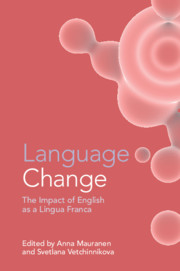Book contents
- Language Change
- Language Change
- Copyright page
- Contents
- Figures
- Tables
- Contributors
- Acknowledgements
- Abbreviations
- Introduction
- Part I Pooling Perspectives
- 1 Calling Englishes As Complex Dynamic Systems: Diffusion and Restructuring
- 2 English as a Lingua Franca in the Context of a Sociolinguistic Typology of Contact Languages
- 3 How Writing Changes Language
- 4 ELF and Translation As Language Contact
- 5 Present-Day Standard English
- 6 Beyond Language Change
- Part II Zooming in on ELF
- Index
- References
1 - Calling Englishes As Complex Dynamic Systems: Diffusion and Restructuring
from Part I - Pooling Perspectives
Published online by Cambridge University Press: 17 December 2020
- Language Change
- Language Change
- Copyright page
- Contents
- Figures
- Tables
- Contributors
- Acknowledgements
- Abbreviations
- Introduction
- Part I Pooling Perspectives
- 1 Calling Englishes As Complex Dynamic Systems: Diffusion and Restructuring
- 2 English as a Lingua Franca in the Context of a Sociolinguistic Typology of Contact Languages
- 3 How Writing Changes Language
- 4 ELF and Translation As Language Contact
- 5 Present-Day Standard English
- 6 Beyond Language Change
- Part II Zooming in on ELF
- Index
- References
Summary
This paper advocates the theory of 'Complex Dynamic Systems', developed in the sciences as a suitable framework for the understanding of the evolution of varieties and uses of English through time and space. After looking into earlier applications of this theory in linguistics, it surveys core properties of such systems and illustrates their relevance by applications to specific processes of change in the history of English. It then investigates processes of lexicosemantic diffusion and syntactic restructuring in World Englishes within this framework, trying to document its applicability.
Keywords
Information
- Type
- Chapter
- Information
- Language ChangeThe Impact of English as a Lingua Franca, pp. 15 - 43Publisher: Cambridge University PressPrint publication year: 2020
References
Accessibility standard: Unknown
Why this information is here
This section outlines the accessibility features of this content - including support for screen readers, full keyboard navigation and high-contrast display options. This may not be relevant for you.Accessibility Information
- 12
- Cited by
